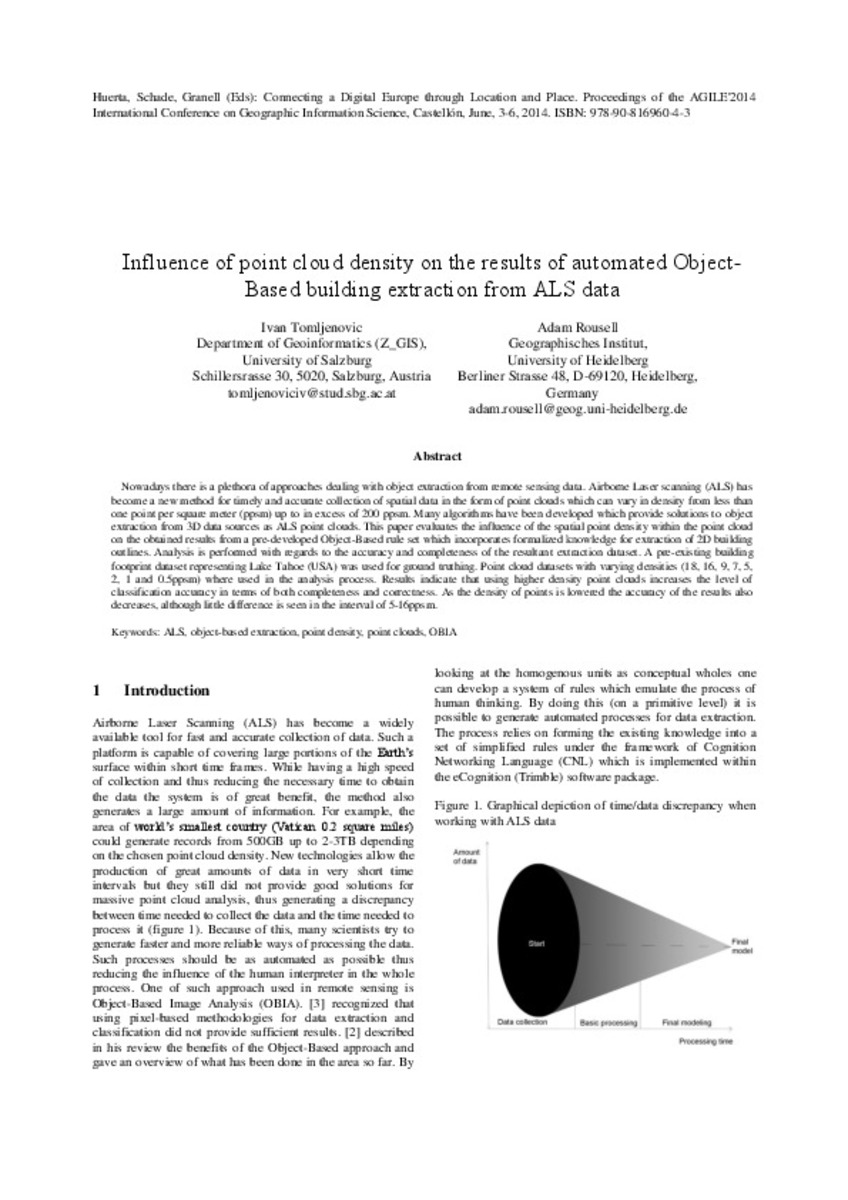Mostrar el registro sencillo del ítem
Influence of point cloud density on the results of automated Object-Based building extraction from ALS data
| dc.contributor | Huerta Guijarro, Joaquín | |
| dc.contributor | Schade, Sven | |
| dc.contributor | Granell Canut, Carlos | |
| dc.contributor.author | Tomljenovic, Ivan | |
| dc.contributor.author | Rousell, Adam | |
| dc.date.accessioned | 2014-07-30T11:32:09Z | |
| dc.date.available | 2014-07-30T11:32:09Z | |
| dc.date.issued | 2014-06 | |
| dc.identifier.isbn | 9789081696043 | |
| dc.identifier.uri | http://hdl.handle.net/10234/98911 | |
| dc.description | Ponencias, comunicaciones y pósters presentados en el 17th AGILE Conference on Geographic Information Science "Connecting a Digital Europe through Location and Place", celebrado en la Universitat Jaume I del 3 al 6 de junio de 2014. | ca_CA |
| dc.description.abstract | Nowadays there is a plethora of approaches dealing with object extraction from remote sensing data. Airborne Laser scanning (ALS) has become a new method for timely and accurate collection of spatial data in the form of point clouds which can vary in density from less than one point per square meter (ppsm) up to in excess of 200 ppsm. Many algorithms have been developed which provide solutions to object extraction from 3D data sources as ALS point clouds. This paper evaluates the influence of the spatial point density within the point cloud on the obtained results from a pre-developed Object-Based rule set which incorporates formalized knowledge for extraction of 2D building outlines. Analysis is performed with regards to the accuracy and completeness of the resultant extraction dataset. A pre-existing building footprint dataset representing Lake Tahoe (USA) was used for ground truthing. Point cloud datasets with varying densities (18, 16, 9, 7, 5, 2, 1 and 0.5ppsm) where used in the analysis process. Results indicate that using higher density point clouds increases the level of classification accuracy in terms of both completeness and correctness. As the density of points is lowered the accuracy of the results also decreases, although little difference is seen in the interval of 5-16ppsm. | ca_CA |
| dc.format.extent | 6 p. | ca_CA |
| dc.format.mimetype | application/pdf | ca_CA |
| dc.language.iso | eng | ca_CA |
| dc.publisher | AGILE Digital Editions | ca_CA |
| dc.relation.isPartOf | Huerta, Schade, Granell (Eds): Connecting a Digital Europe through Location and Place. Proceedings of the AGILE'2014 International Conference on Geographic Information Science, Castellón, June, 3-6, 2014. ISBN: 978-90-816960-4-3 | ca_CA |
| dc.rights.uri | http://rightsstatements.org/vocab/CNE/1.0/ | * |
| dc.subject | Association of Geographic Information Laboratories for Europe ( AGILE) Conference | ca_CA |
| dc.subject | Geographic Information Science | ca_CA |
| dc.subject | Información geográfica | ca_CA |
| dc.subject | ALS | ca_CA |
| dc.subject | object-based extraction | ca_CA |
| dc.subject | point density | ca_CA |
| dc.subject | point clouds | ca_CA |
| dc.subject | OBIA | ca_CA |
| dc.title | Influence of point cloud density on the results of automated Object-Based building extraction from ALS data | ca_CA |
| dc.type | info:eu-repo/semantics/bookPart | ca_CA |
| dc.rights.accessRights | info:eu-repo/semantics/openAccess | ca_CA |







